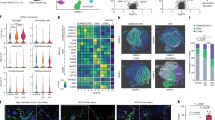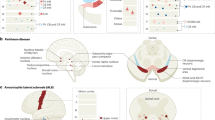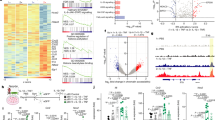Abstract
Cellular senescence, which is characterized by an irreversible cell-cycle arrest1 accompanied by a distinctive secretory phenotype2, can be induced through various intracellular and extracellular factors. Senescent cells that express the cell cycle inhibitory protein p16INK4A have been found to actively drive naturally occurring age-related tissue deterioration3,4 and contribute to several diseases associated with ageing, including atherosclerosis5 and osteoarthritis6. Various markers of senescence have been observed in patients with neurodegenerative diseases7,8,9; however, a role for senescent cells in the aetiology of these pathologies is unknown. Here we show a causal link between the accumulation of senescent cells and cognition-associated neuronal loss. We found that the MAPTP301SPS19 mouse model of tau-dependent neurodegenerative disease10 accumulates p16INK4A-positive senescent astrocytes and microglia. Clearance of these cells as they arise using INK-ATTAC transgenic mice prevents gliosis, hyperphosphorylation of both soluble and insoluble tau leading to neurofibrillary tangle deposition, and degeneration of cortical and hippocampal neurons, thus preserving cognitive function. Pharmacological intervention with a first-generation senolytic modulates tau aggregation. Collectively, these results show that senescent cells have a role in the initiation and progression of tau-mediated disease, and suggest that targeting senescent cells may provide a therapeutic avenue for the treatment of these pathologies.
This is a preview of subscription content, access via your institution
Access options
Access Nature and 54 other Nature Portfolio journals
Get Nature+, our best-value online-access subscription
$29.99 / 30 days
cancel any time
Subscribe to this journal
Receive 51 print issues and online access
$199.00 per year
only $3.90 per issue
Buy this article
- Purchase on Springer Link
- Instant access to full article PDF
Prices may be subject to local taxes which are calculated during checkout




Similar content being viewed by others
Data availability
All source data and exact P values (if applicable) for every figure are included in the supporting information that accompanies the paper.
References
Hayflick, L. & Moorhead, P. S. The serial cultivation of human diploid cell strains. Exp. Cell Res. 25, 585–621 (1961).
Coppé, J. P. et al. Senescence-associated secretory phenotypes reveal cell-nonautonomous functions of oncogenic RAS and the p53 tumor suppressor. PLoS Biol. 6, e301 (2008).
Baker, D. J. et al. Naturally occurring p16Ink4a-positive cells shorten healthy lifespan. Nature 530, 184–189 (2016).
Baker, D. J. et al. Clearance of p16Ink4a-positive senescent cells delays ageing-associated disorders. Nature 479, 232–236 (2011).
Childs, B. G. et al. Senescent intimal foam cells are deleterious at all stages of atherosclerosis. Science 354, 472–477 (2016).
Jeon, O. H. et al. Local clearance of senescent cells attenuates the development of post-traumatic osteoarthritis and creates a pro-regenerative environment. Nat. Med. 23, 775–781 (2017).
Bhat, R. et al. Astrocyte senescence as a component of Alzheimer’s disease. PLoS ONE 7, e45069 (2012).
Tan, F. C., Hutchison, E. R., Eitan, E. & Mattson, M. P. Are there roles for brain cell senescence in aging and neurodegenerative disorders? Biogerontology 15, 643–660 (2014).
Luo, X. G., Ding, J. Q. & Chen, S. D. Microglia in the aging brain: relevance to neurodegeneration. Mol. Neurodegener. 5, 12 (2010).
Yoshiyama, Y. et al. Synapse loss and microglial activation precede tangles in a P301S tauopathy mouse model. Neuron 53, 337–351 (2007).
Childs, B. G. et al. Senescent cells: an emerging target for diseases of ageing. Nat. Rev. Drug Discov. 16, 718–735 (2017).
Dimri, G. P. et al. A biomarker that identifies senescent human cells in culture and in aging skin in vivo. Proc. Natl Acad. Sci. USA 92, 9363–9367 (1995).
Stollewerk, A., Klămbt, C. & Cantera, R. Electron microscopic analysis of Drosophila midline glia during embryogenesis and larval development using beta-galactosidase expression as endogenous cell marker. Microsc. Res. Tech. 35, 294–306 (1996).
Ming, G. L. & Song, H. Adult neurogenesis in the mammalian brain: significant answers and significant questions. Neuron 70, 687–702 (2011).
Buenz, E. J. et al. Apoptosis of hippocampal pyramidal neurons is virus independent in a mouse model of acute neurovirulent picornavirus infection. Am. J. Pathol. 175, 668–684 (2009).
Chang, J. et al. Clearance of senescent cells by ABT263 rejuvenates aged hematopoietic stem cells in mice. Nat. Med. 22, 78–83 (2016).
Zhu, Y. et al. Identification of a novel senolytic agent, navitoclax, targeting the Bcl-2 family of anti-apoptotic factors. Aging Cell 15, 428–435 (2016).
Karpel-Massler, G. et al. Induction of synthetic lethality in IDH1-mutated gliomas through inhibition of Bcl-xL. Nat. Commun. 8, 1067 (2017).
Flanary, B. E., Sammons, N. W., Nguyen, C., Walker, D. & Streit, W. J. Evidence that aging and amyloid promote microglial cell senescence. Rejuvenation Res. 10, 61–74 (2007).
Salminen, A. et al. Astrocytes in the aging brain express characteristics of senescence-associated secretory phenotype. Eur. J. Neurosci. 34, 3–11 (2011).
Streit, W. J., Braak, H., Xue, Q. S. & Bechmann, I. Dystrophic (senescent) rather than activated microglial cells are associated with tau pathology and likely precede neurodegeneration in Alzheimer’s disease. Acta Neuropathol. 118, 475–485 (2009).
Chinta, S. J. et al. Cellular senescence is induced by the environmental neurotoxin paraquat and contributes to neuropathology linked to Parkinson’s disease. Cell Rep. 22, 930–940 (2018).
Kasper, L. H. et al. CREB binding protein interacts with nucleoporin-specific FG repeats that activate transcription and mediate NUP98-HOXA9 oncogenicity. Mol. Cell. Biol. 19, 764–776 (1999).
Baker, D. J. et al. Opposing roles for p16Ink4a and p19Arf in senescence and ageing caused by BubR1 insufficiency. Nat. Cell Biol. 10, 825–836 (2008).
Parent, J. M., von dem Bussche, N. & Lowenstein, D. H. Prolonged seizures recruit caudal subventricular zone glial progenitors into the injured hippocampus. Hippocampus 16, 321–328 (2006).
Ly, P. T., Cai, F. & Song, W. Detection of neuritic plaques in Alzheimer’s disease mouse model. J. Vis. Exp. 53, 2831 (2011).
Oh, K. J. et al. Staging of Alzheimer’s pathology in triple transgenic mice: a light and electron microscopic analysis. Int. J. Alzheimers Dis. 2010, 780102 (2010).
Yang, Z. et al. Age-related decline in BubR1 impairs adult hippocampal neurogenesis. Aging Cell 16, 598–601 (2017).
Kumamaru, H. et al. Liposomal clodronate selectively eliminates microglia from primary astrocyte cultures. J. Neuroinflammation 9, 116 (2012).
Gordon, R. et al. A simple magnetic separation method for high-yield isolation of pure primary microglia. J. Neurosci. Methods 194, 287–296 (2011).
Tsay, H. J. et al. Amyloid β peptide-mediated neurotoxicity is attenuated by the proliferating microglia more potently than by the quiescent phenotype. J. Biomed. Sci. 20, 78 (2013).
Chao, C. C., Hu, S., Molitor, T. W., Shaskan, E. G. & Peterson, P. K. Activated microglia mediate neuronal cell injury via a nitric oxide mechanism. J. Immunol. 149, 2736–2741 (1992).
Wang, G. et al. Apoptosis and proinflammatory cytokine responses of primary mouse microglia and astrocytes induced by human H1N1 and avian H5N1 influenza viruses. Cell. Mol. Immunol. 5, 113–120 (2008).
Schindelin, J. et al. Fiji: an open-source platform for biological-image analysis. Nat. Methods 9, 676–682 (2012).
Chung, I. Y. & Benveniste, E. N. Tumor necrosis factor-alpha production by astrocytes. Induction by lipopolysaccharide, IFN-gamma, and IL-1 beta. J. Immunol. 144, 2999–3007 (1990).
Acknowledgements
The authors thank C. H. Cho for numerous contributions to the experiments; the laboratory of C. Howe and specifically M. Standiford for help with the microglia and astrocyte cultures; M. Poeschla for assistance with the phospho-tau immunohistochemistry; G. Nelson for genotyping and animal support; B. Childs for input and assistance in Gal-TEM; the Mayo Clinic Microscopy and Cell Analysis Core and staff for assistance with flow cytometry and transmission electron microscopy; the Mayo Clinic Medical Genome Facility Gene Expression Core for RT–qPCR instrumentation; and R. Petersen and C. Howe for feedback on the manuscript. This work was supported by the Ellison Medical Foundation, the Glenn Foundation for Medical Research, the National Institutes of Health (R01AG053229), the Mayo Clinic Children’s Research Center and the Alzheimer’s Disease Research Center of Mayo Clinic (all to D.J.B.).
Reviewer information
Nature thanks M. Serrano and the other anonymous reviewer(s) for their contribution to the peer review of this work.
Author information
Authors and Affiliations
Contributions
T.J.B. and A.A. performed most of the experiments. C.F.M. assisted with the senescent cell identification by Gal-TEM and FACS. B.L.S. performed immunohistochemistry assessments. J.M.v.D. assisted with experimental design and data interpretation. The manuscript was written by T.J.B. and D.J.B. All authors discussed results, made figures and edited the manuscript. D.J.B. conceived, directed and supervised all aspects of the study.
Corresponding author
Ethics declarations
Competing interests
D.J.B. and J.M.v.D. are co-inventors on patent applications licensed to or filed by Unity Biotechnology, a company developing senolytic medicines, including small molecules that selectively eliminate senescent cells. J.M.v.D. is a co-founder of Unity Biotechnology. Research in the Baker laboratory has been reviewed by the Mayo Clinic Conflict of Interest Review Board and is being conducted in compliance with Mayo Clinic Conflict of Interest policies.
Additional information
Publisher’s note: Springer Nature remains neutral with regard to jurisdictional claims in published maps and institutional affiliations.
Extended data figures and tables
Extended Data Fig. 1 Senescent cells accumulate in PS19 mice.
RT–qPCR analysis of senescence-associated genes in hippocampi (left) and cortices (right) of three- and ten-month-old male mice. Number of mice is as indicated, two independent experiments; normalized to the three-month wild-type group. Data are mean ± s.e.m. *P < 0.05; **P < 0.01; ***P < 0.001 (one-way ANOVA with Tukey’s multiple comparisons test). Exact P values can be found in the accompanying Source Data.
Extended Data Fig. 2 AP-mediated clearance selectively removes senescent cells that accumulate in the brains of PS19;ATTAC mice.
RT–qPCR analysis of the expression of senescence markers in the hippocampus (left) and cortex (right) of six-month-old female mice, treated with either vehicle (–AP) or AP20187 (+AP). Number of mice is as indicated; normalized to the ATTAC – AP group. Data are mean ± s.e.m. *P < 0.05; **P < 0.01; ***P < 0.001 (one-way ANOVA with Tukey’s multiple comparisons test). Exact P values can be found in the accompanying Source Data.
Extended Data Fig. 3 Neurons do not exhibit X-Gal crystals upon Gal-TEM imaging.
Representative electron microscopy image of neurons after SA-β-Gal staining from a six-month-old, vehicle-treated PS19;ATTAC male mouse (n = 3 male mice, 2 independent experiments). The image has been artificially coloured to show individual cell bodies. Scale bar, 10 µm.
Extended Data Fig. 4 Increased expression of senescence-associated genes is observed in astrocytes and microglia isolated from PS19 mice.
a–e, Gating strategy (a) for FACS isolation of living astrocytes (b), microglia (c), oligodendrocytes (d) and neuron-enriched CD56+ cells (e) from cortices of six-month-old wild-type and PS19 mice. b, Astrocyte (CD11b−CD45−O1−GLAST+CD56−) fraction (left) and RT–qPCR analysis (right). c, Microglia (CD11b+CD45+O1GLAST+CD56−) fraction (left) and RT–qPCR analysis (right). d, Oligodendrocyte (CD11b−CD45−O1+GLAST−CD56–) fraction (left) and RT–qPCR analysis (right). e, Neuron-enriched CD56+ (CD11b−CD45−O1−GLAST−CD56+) fraction (left) and RT–qPCR analysis (right). Individual numbers of independent mouse cell population isolations are indicated in the parentheses above p16Ink4a columns (2 independent experiments). Data are mean ± s.e.m. *P < 0.05; **P < 0.01 (unpaired two-sided t-tests with Welch’s correction). Exact P values can be found in the accompanying Source Data.
Extended Data Fig. 5 Verification of the identity of cell populations isolated by FACS.
a–d, RT–qPCR analysis of cell-identity markers from cell populations isolated from six-month-old wild-type and PS19 mice: Aqp4 expression enriched in astrocytes (a), Cx3cr1 expression enriched in microglia (b), Olig2 expression enriched in oligodendrocytes (c) and Nefl expression enriched in neurons (d). Expression is normalized to intact cortices of six-month-old wild-type mice (n = 4 biologically independent cell isolations for each group, 2 independent experiments). Data are mean ± s.e.m. ***P < < 0.001 (one-way ANOVA with Tukey’s multiple comparisons test). Exact P values can be found in the accompanying Source Data.
Extended Data Fig. 6 AP administration does not erroneously eliminate non-senescent glial cells isolated from ATTAC mice.
a, CD11b staining of primary microglia treated with IFNγ (200 ng ml−1), LPS (100 ng ml−1) or a combination of both (n = 3 biologically independent samples). b, Quantification of TUNEL-positive bodies in basal or activated microglia (n = 4 wild-type and 8 ATTAC cultures for each treatment group, 2 independent experiments). c, GFAP staining of primary astrocytes treated with IFNγ, LPS or a combination of both as described in a (n = 3 biologically independent samples). d, Quantification of the change in confluency over 24 h in basal or activated astrocytes (n = 4 biologically independent cultures of each genotype and treatment). Scale bars, 100 μm (a, c). Data are mean ± s.e.m. *P < 0.05; ***P < 0.001 (one-way ANOVA with Tukey’s multiple comparisons test (b, d)). Exact P values can be found in the accompanying Source Data.
Extended Data Fig. 7 Administration of AP does not broadly eliminate cells or increase proliferation of microglia.
a, Quantification of TUNEL-positive bodies (as a percentage of all cells) at the transition between the CA2 and CA3 within the hippocampus after a short-term AP administration in six-month-old mice (n = 3 mice per genotype and treatment group). b, Quantification of IBA1/EdU double-positive cells in the hippocampus and cortex of six-month-old mice that were administered AP beginning at weaning age (n = 4 mice per genotype and treatment group). Data are mean ± s.e.m. We note that no comparison is statistically significant (one-way ANOVA with Tukey’s multiple comparisons test). Exact P values can be found in the accompanying Source Data.
Extended Data Fig. 8 Senescent cells promote gliosis.
a, RT–qPCR analysis of Gfap, S100b and Cd11b in the hippocampi of six-month-old male mice (n = 5 mice per group; normalized to the ATTAC – AP group). b, RT–qPCR analysis as in a in hippocampi of six-month-old female mice (number of mice as indicated; normalized to the ATTAC – AP group). c, Representative GFAP immunohistochemistry staining in the hippocampus of six-month-old vehicle and AP-treated ATTAC and PS19;ATTAC female mice (n = 4 mice per group, 2 independent experiments). d, Representative IBA1 staining in the hippocampus of six-month-old vehicle and AP-treated ATTAC and PS19;ATTAC female mice (n = 4 mice per group, 2 independent experiments). Scale bar, 100 µm (c) and 50 µm (d). Data are mean ± s.e.m. *P < 0.05; **P < 0.01; ***P < 0.001 (one-way ANOVA with Tukey’s multiple comparisons test). Exact P values can be found in the accompanying Source Data.
Extended Data Fig. 9 AP treatment attenuates tau phosphorylation.
a, Ponceau-S loading controls for the western-blot lysates of the whole brain of six-month-old mice (shown in Fig. 3a) for total tau (left) and phosphorylated tau (S202/T205; right). b, Quantification of the western-blot analysis of the whole brain of six-month-old mice for soluble tau (left), soluble phosphorylated tau (S202/T205; middle), and insoluble phosphorylated tau (S202/T205; right). Numbers of biologically independent mice are indicated in parentheses, data are from ≥3 independent experiments. c, Immunostaining of the cortex of six-month-old mice for tau protein phosphorylated at T231 (top) and S396 (bottom; n = 4 mice per group, 2 independent experiments). Scale bar, 100 µm. Data are mean ± s.e.m. ***P < 0.001 (one-way ANOVA with Tukey’s multiple comparisons test). Exact P values can be found in the accompanying Source Data.
Extended Data Fig. 10 Vision-based novel-object discrimination remains intact in AP-treated PS19;ATTAC mice.
Objects used for novel-object recognition during the training and testing phases for visual discrimination (left) and the average ratio for the number of investigations (right, n = 8 female mice per group). Data are mean ± s.e.m. **P < 0.01; ***P < 0.001 (two-way ANOVA with Tukey’s multiple comparisons test). Exact P values can be found in the accompanying Source Data.
Supplementary information
Supplementary Figure 1
This file contains the uncropped scans with size marker indications.
Source data
Rights and permissions
About this article
Cite this article
Bussian, T.J., Aziz, A., Meyer, C.F. et al. Clearance of senescent glial cells prevents tau-dependent pathology and cognitive decline. Nature 562, 578–582 (2018). https://doi.org/10.1038/s41586-018-0543-y
Received:
Accepted:
Published:
Issue Date:
DOI: https://doi.org/10.1038/s41586-018-0543-y
Keywords
This article is cited by
-
A nonhuman primate model with Alzheimer’s disease-like pathology induced by hippocampal overexpression of human tau
Alzheimer's Research & Therapy (2024)
-
The interaction between ageing and Alzheimer's disease: insights from the hallmarks of ageing
Translational Neurodegeneration (2024)
-
Emerging role of senescent microglia in brain aging-related neurodegenerative diseases
Translational Neurodegeneration (2024)
-
Metformin normalizes mitochondrial function to delay astrocyte senescence in a mouse model of Parkinson’s disease through Mfn2-cGAS signaling
Journal of Neuroinflammation (2024)
-
Lessons from inducible pluripotent stem cell models on neuronal senescence in aging and neurodegeneration
Nature Aging (2024)
Comments
By submitting a comment you agree to abide by our Terms and Community Guidelines. If you find something abusive or that does not comply with our terms or guidelines please flag it as inappropriate.



